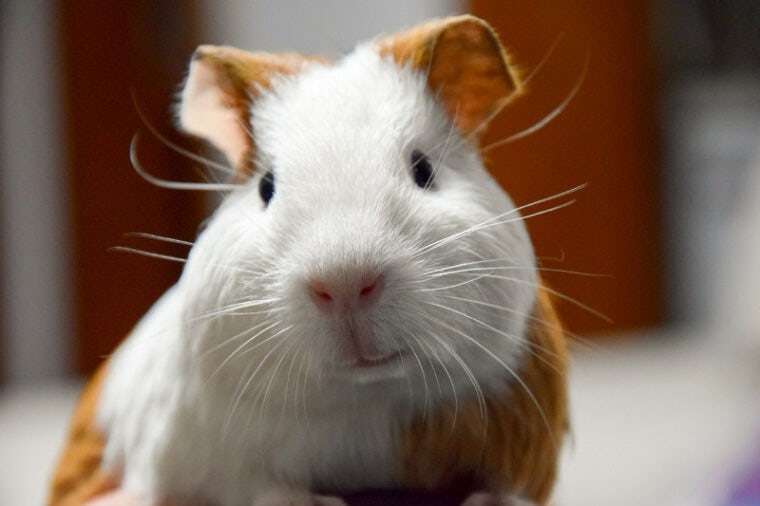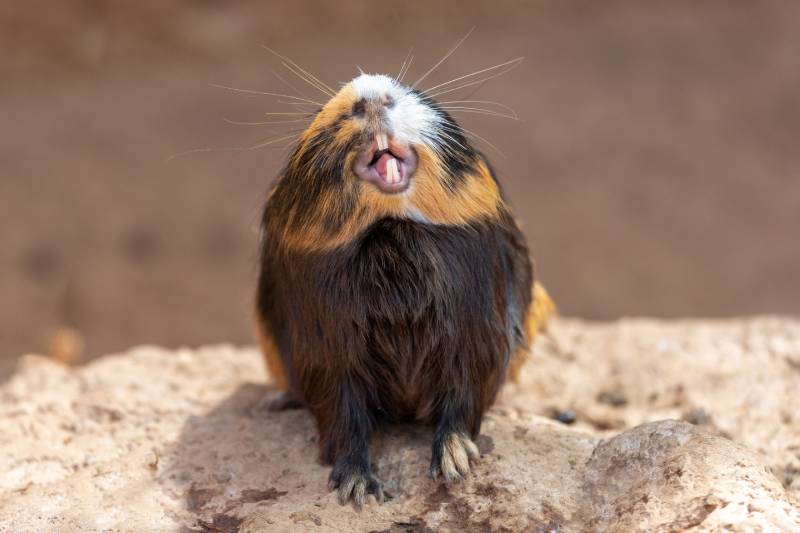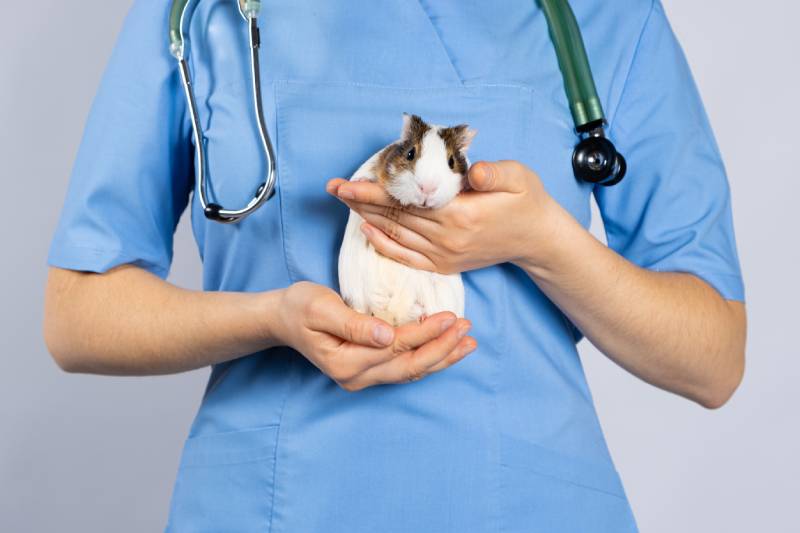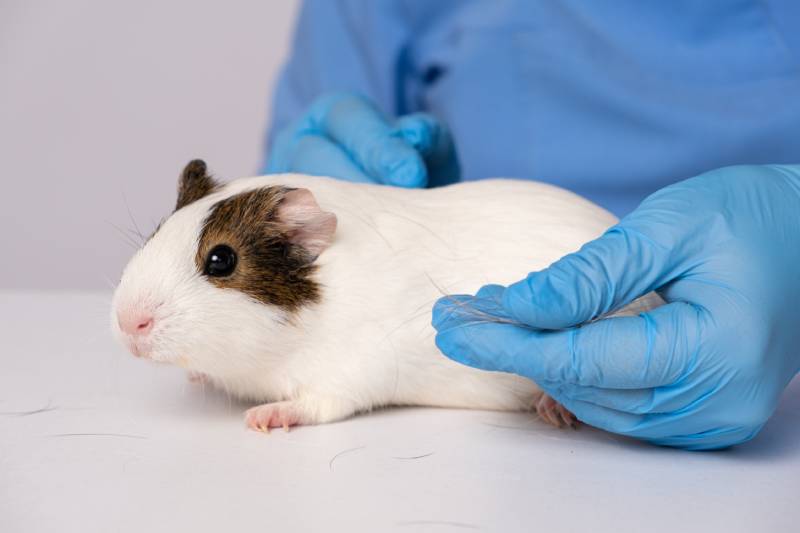
Guinea pigs are popular, adorable pet rodents that have their own unique health problems. Some of these are more frequently encountered than others, and here we’ll learn about eight of their common health concerns. Knowing about these diseases can be helpful to the diligent guinea pig owner by giving them good tools for disease prevention and by being aware of signs to watch for so that veterinary care can be sought out early.
So, let’s delve into some common health issues of these cuties!
The 8 Guinea Pig Health Issues
1. Dental Disease/Malocclusion
You may be surprised to learn that a guinea pig’s teeth grow continuously throughout its life! In a normal situation, the teeth wear on each other—for example, the top teeth achieve a normal length by wearing against the bottom ones to keep their growth in check. If the mouth or jaw is not aligned properly, often due to genetics, diet, or trauma, the teeth that are not able to wear correctly will overgrow. This can cause a hard time for a guinea pig with eating or drinking but drooling or slobbering can also be a sign that there is a problem.
In cases where the teeth are regularly overgrowing, dental trimming will need to be done—this can be a recurring need throughout the guinea pig’s life. Pets with this condition should not be bred and a proper diet can help in some cases.

2. Respiratory Infections/Pneumonia
Pneumonia, or inflammation of the lungs, can be due to a bacterial (more commonly seen) or viral respiratory infection. This can be seen in animals that are housed in damp or humid environments but exposure to others (both sick animals or other even healthy species such as dogs or rabbits) can also play a role. Stress, age, poor nutrition, or poor sanitation in their environment can make guinea pigs more susceptible to this disease. Signs seen can include fast or difficult breathing, lethargy, decreased appetite, and eye or nose discharge although sometimes sudden death is the first and only sign.
Treatment includes antibiotics (for bacterial cases) and supportive care like intravenous (IV) fluids, oxygen treatment, vitamin C, and syringe feeding.
3. Pododermatitis
This disease is also commonly called “bumblefoot” and is most frequently found in guinea pigs that are walking on the wire bottoms of cages or an abrasive bedding material—an overweight guinea pig is also a risk factor. The affected feet will develop a thickened outer layer of skin that then will ulcerate and form a secondary bacterial infection. The infection can then ascend through the thickened skin up into the leg into the tendons and bone. Guinea pigs with pododermatitis are often in extreme pain and often vocal about their discomfort as well as not wanting to walk.
Removal of the damaged tissue, antibiotics, pain medication, foot soaks, and wound bandaging will be needed. Despite this, healing can still be a difficult endeavor and some pets may even need amputation. Prevention is key by having a dry, clean, non-abrasive environment coupled with weight management.

4. Ovarian Cyst
Female guinea pigs over 1-year-old can often develop cysts that occur spontaneously on their ovaries. They can be present on just one ovary but are most often present on both, are accompanied by a clear fluid, and can continue to grow in size. These cysts can signify reduced reproductive performance, but affected pets can also display hair loss, decreased appetite, distension of their belly, and lethargy.
X-rays and ultrasound are helpful for diagnosing and treatment is surgical removal of the ovary and cysts via spaying.
5. Cervical Lymphadenitis
This is also commonly referred to as “lumps” and can even be caused by normal bacteria strains located in the mouth and nasal areas of guinea pigs. If there is an injury in these areas, (for example, an abrasion injuring the lining of the mouth by overgrown teeth or something sharp such as hay), this can allow the bacteria to move to and “take up shop” in the cervical lymph nodes (located just below the jaw on the underside of the neck). Once an infection is underway, this causes an abscess (an infected, swollen area with pus) which causes large swellings on the underside of the affected guinea pig’s neck.
Antibiotics will be needed for treatment and in severe cases, surgery or draining and flushing of the affected lymph nodes could need to be performed. Prevention is key by having a stress-free environment, a good diet, and proper dental hygiene.

6. Urolithiasis
Urolithiasis is another term for calculi (or stones) that form in the urinary tract which could include the kidney, ureter, bladder, or urethra. Signs can include lethargy, poor appetite, a huddled hunched posture, bloody urine, or not being able to urinate at all. Sometimes in physical exams, they may be felt, but X-rays and/or ultrasounds are typically needed for diagnosis.
Depending on the location, they may be able to be flushed to prevent complete urinary obstruction or surgery may need to be performed to remove the stones.
7. Dermatophytosis
This is more commonly referred to as a fungal infection and is a fairly common occurrence in these guys. Most often, the infection occurs on the face, back, or front feet. Hair loss is often the first sign, and itchiness is surprisingly minor or often not present at all. There can be variable inflammatory red lesions with pimple-like bumps, crusts, or scaly skin. Treatment should consist of an oral antifungal coupled with potential topical therapy and may last for a few months based on the skin scrape lab results.
It is important to treat not only the guinea pig but also their environment as well to prevent reinfection. A fungal infection is also zoonotic, meaning it can spread from the affected animal to people or vice versa!

8. Trichofolliculoma
A trichofolliculoma is the most common skin tumor seen in guinea pigs of any age or sex. There can be one or multiple tumors, and they are typically 4–5 cm (1.5–2 inches) in size. These growths may appear anywhere on a guinea pig’s body, but they are most common along the back and near the hip regions. While these are benign growths, a guinea pig may over-groom on and around these tumors which can cause bleeding, ulceration, or a secondary skin infection.
Treatment of the tumor is surgical removal and resolves the problem.
Summary
While guinea pigs are awfully cute, they come with their own special cases of medical issues based on their unique anatomy and physiology. And while there are still more frequently encountered guinea pig health issues to learn about, this list of eight common ones will be a great starting place to learn a little bit more about your pet, what they need, and when to seek further medical care!
Featured Image Credit: rubyclement, Pixabay









